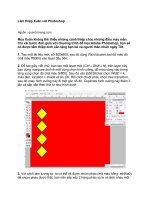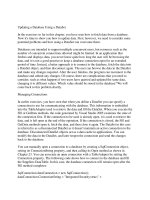Tài liệu Digital Character Painting Using Photoshop CS3 P1 docx
Bạn đang xem bản rút gọn của tài liệu. Xem và tải ngay bản đầy đủ của tài liệu tại đây (1.41 MB, 40 trang )
D
IGITAL
C
HARACTER
P
AINTING
U
SING
P
HOTOSHOP
®
CS3
D
ON
S
EEGMILLER
C
HARLES
R
IVER
M
EDIA
Boston, Massachusetts
Publisher and General Manager, Charles River Media: Stacy L. Hiquet
Associate Director of Marketing: Sarah O’Donnell
Manager of Editorial Services: Heather Talbot
Marketing Manager: Jordan Casey
Marketing Assistant: Adena Flitt
Project Editor: Karen A. Gill
Technical Reviewer: Howard Lyon
CRM Editorial Services Coordinator: Jennifer Blaney
Copy Editor: Ruth Saavedra
Interior Layout Tech: Judy Littlefield
Cover Designer: Tyler Creative
Cover Images: Don Seegmiller
CD-ROM Producer: Brandon Penticuff
Indexer: Valerie Perry
Proofreader: Melba Hopper
Charles River Media, Inc.
25 Thomson Place
Boston, MA 02210
617-757-7900
617-757-7969 (fax)
www.charlesriver.com
This book is printed on acid-free paper.
Don Seegmiller. Digital Character Painting Using Photoshop CS3
.
ISBN-10: 1-58450-533-8
ISBN-13: 978-1-58450-533-4
Library of Congress Catalog Card Number: 2007931939
All brand names and product names mentioned in this book are trademarks or service marks of their respective
companies. Any omission or misuse (of any kind) of service marks or trademarks should not be regarded as intent to
infringe on the property of others. The publisher recognizes and respects all marks used by companies, manufactur-
ers, and developers as a means to distinguish their products.
Printed in Canada
08 09 10 11 12 TC 10 9 8 7 6 5 4 3 2 1
Charles River Media titles are available for site license or bulk purchase by institutions, user groups, corporations,
etc. For additional information, please contact the Special Sales Department at 800-347-7707.
Requests for replacement of a defective CD-ROM must be accompanied by the original disc, your mailing address,
telephone number, date of purchase, and purchase price. Please state the nature of the problem, and send the infor-
mation to Charles River Media, Inc., 25 Thomson Place, Boston, MA 02210. CRM’s sole obligation to the purchaser
is to replace the disc, based on defective materials or faulty workmanship, but not on the operation or functionality
of the product.
Copyright 2008 Career & Professional Group, a division of Thomson Learning Inc. Published by Charles River Media,
an Imprint of Thomson Learning Inc. All rights reserved.
No part of this publication may be reproduced in any way, stored in a retrieval system of any type, or transmitted
by any means or media, electronic or mechanical, including, but not limited to, photocopy, recording, or scanning,
without prior permission in writing from the publisher.
eISBN-10: 1-58450-602-4
This book is dedicated to my family;
in particular, Marti, my dear wife,
who has always helped keep my vision clear
and my perspective correct.
This page intentionally left blank
C
ONTENTS
P
REFACE
xvii
I
NTRODUCTION
xxi
P
ART
IC
HARACTER
D
ESIGN
1
C
HAPTER
1I
NTRODUCTION TO
C
HARACTER
D
ESIGN
3
What Is Character Design? 6
Character Design Issues and Limitations 8
Conclusion 11
C
HAPTER
2D
EVELOPING A
W
ORKING
M
ETHOD
13
The Need for a Methodical and Successful Way of Working 14
Identifying and Understanding the Problem 14
Analyzing the Problem and Breaking It Down into Simpler Elements 16
Choosing the Best Idea 16
Drawing the Character 16
Evaluating the Results 16
Conclusion 17
C
HAPTER
3E
XPANDING ON
Y
OUR
I
DEAS
W
HEN
C
REATING THE
C
HARACTER
19
Basic Strategies to Help Generate Creative Ideas 20
Learning to Relax 20
Locating Useful Reference Materials 22
v
Using Wordplay 22
Fantasizing About the Character 22
Using Symbolism with the Character 23
Building the Character Around a Myth 23
Snowballing 23
Visiting Special Places for Inspiration 23
Developing Your Basic Idea 24
Using Caricature 25
Using Humor 25
Using Blotter Pictures 26
Using Exaggeration 27
Using Satire 28
Using Parody 28
Doing Some Expression Exercises 28
Doing Some Five-Dot Action Exercises 29
Using Folded Paper 29
Using Idealization 29
Adding and Subtracting 29
Using Repetition 29
Using Combinations 30
Transferring Characteristics 30
Superimposing 30
Changing the Scale 30
Substituting 30
Distorting 30
Disguising the Character 31
Using Analogy 31
Creating a Hybrid 31
Evolving the Character 31
Changing the Character with Metamorphosis and Mutation 31
Using Metaphors 31
Using Visual Puns 32
Doodling and Scribbling 32
Making Things Look Strange, or Transforming the Ordinary into the Fantastic 32
Using Mimicry 32
Conclusion 32
vi
Contents
Contents
vii
C
HAPTER
4M
AKING THE
C
HARACTER
R
EAL BY
C
REATING A
C
HARACTER
H
ISTORY
33
Creating the Character’s History 34
The Character’s Past, Present, and Future 34
The Character’s Everyday Environment 35
The Character’s Personality 35
The Character’s Personality Traits 36
The Character’s Look 37
Conclusion 37
C
HAPTER
5D
ESIGNING THE
P
HYSICAL
L
OOK OF
Y
OUR
C
HARACTER
39
Describing the Character 40
The Character’s General Physical Characteristics 40
The Character’s Body Type 40
The Character’s Proportions 42
The Character’s Makeup 42
The Character’s Gender 42
The Character’s Surface 42
The Character’s Color 43
The Character’s Facial Structure 43
The Character’s Movement 43
Other Considerations 44
The Visual Issues of Character Design and How to Communicate Your Ideas 44
Conclusion 45
P
ART
II A
RTISTIC
P
RINCIPLES FOR A
D
IGITAL
A
GE
47
C
HAPTER
6B
ASIC
P
RINCIPLES FOR
I
MPROVING THE
D
RAWING
,
S
KETCHING
,
AND
P
AINTING OF
Y
OUR
C
HARACTER
49
Some Basic Ideas About Drawing 50
Some Basic Ideas About Painting Figures, Hair, and Flesh Tones 52
The Art Part: Sketching, Drawing, and Painting the Character 54
Conclusion 55
C
HAPTER
7V
ALUE AND
I
TS
U
SE IN
P
ICTURE
M
AKING
57
What Is Value? 59
How to Use Value Effectively in Your Art 64
Rules for Using Value in Your Images 69
Conclusion 71
C
HAPTER
8C
OLOR AND
I
TS
U
SE IN
P
ICTURE
M
AKING
73
The Four Primary Characteristics of Color 74
Hue 74
Value 75
Chroma 75
Temperature 75
Secondary Color Characteristics 76
Color Quality 76
Color Distance 76
Color Weight 77
How Color Acts and Reacts 78
Simultaneous Contrast 78
Color Contrast 79
Using Colors Effectively 79
Conclusion 80
C
HAPTER
9U
SING
L
IGHTING
A
RRANGEMENTS TO
L
IGHT A
C
HARACTER
E
FFECTIVELY
81
Using Lighting to Create Striking Art 82
The Main Types of Lighting 83
Positioning Your Lights 87
The Color of Your Lights 94
A Last Word About Shadows 94
Conclusion 96
C
HAPTER
10 U
SING
E
DGES
W
HEN
P
AINTING A
P
ICTURE
97
Types of Edges 98
How Edges Interact 101
Edges and Value 101
Edges and Color 102
Where You Will Find the Different Types of Edges 106
Conclusion 107
viii
Contents
Contents
ix
C
HAPTER
11 B
LENDING
E
DGES IN
Y
OUR
D
IGITAL
P
AINTINGS
109
A New Method for Blending the Edge Where Your Colors and Shapes Meet 110
Optional Blending Method 123
Conclusion 126
C
HAPTER
12 C
REATING
T
EXTURES AND
P
ATTERNS FOR
U
SE IN
D
IGITAL
P
AINTING
127
Creating Textures 128
Creating Textures from Photographic Reference Materials 128
Photoshop’s Pattern Maker 136
Creating Hand-Drawn Textures from Scratch 139
Conclusion 141
C
HAPTER
13 P
HOTOSHOP
B
RUSHES
143
Section 1: The Basics of Photoshop Brushes 144
Where Are the Photoshop Brushes? 144
How to Change Brush Properties 148
Section 2: The Photoshop Brushes Palette 152
Brush Presets 154
Brush Tip Shape 154
Shape Dynamics 159
Scattering 162
Texture 163
Dual Brush 165
Color Dynamics 165
Other Dynamics 169
Section 3: Creating Your Own Photoshop Brushes 172
Creating and Saving Brushes in Photoshop 172
Creating a Custom Brush in Photoshop Using a Photographic Texture 175
Creating Brush Libraries of Your Custom Brushes 180
Conclusion 182
P
ART
III D
IGITAL
P
AINTING
: B
RINGING
I
T
A
LL
T
OGETHER
IN
P
HOTOSHOP
CS3 183
C
HAPTER
14 P
AINTING AN
E
YE
189
What You Need to Know About Photoshop for This Chapter 190
T
UTORIAL
14.1 Painting the Window into a Character’s Soul, the Eye 190
Conclusion 195
C
HAPTER
15 P
AINTING A
F
ACE
197
T
UTORIAL
15.1 General Working Methods You May Want to Use When Painting a Face 198
Conclusion 210
C
HAPTER
16 P
AINTING
H
AIR
211
What You Need to Know About Photoshop for This Chapter 212
T
UTORIAL
16.1 A Technique for Painting Long, Dark Hair 212
Conclusion 226
C
HAPTER
17 P
AINTING
F
ISH
F
ACE
227
What You Need to Know About Photoshop for This Chapter 228
T
UTORIAL
17.1 Painting Fish Face 228
Conclusion 251
C
HAPTER
18 P
AINTING A
S
TRANGE
-L
OOKING
C
HARACTER
253
What You Need to Know About Photoshop for This Chapter 254
T
UTORIAL
18.1 Getting Started 255
T
UTORIAL
18.2 Painting a Face Using a Cool Color Scheme 259
T
UTORIAL
18.3 Painting a Face Using a Warm Color Scheme 272
Conclusion 280
C
HAPTER
19 P
AINTING A
F
RIENDLY
D
RAGON
281
What You Need to Know About Photoshop for This Chapter 282
T
UTORIAL
19.1 Painting a Rather Silly Looking but Friendly Dragon 282
x
Contents
Contents
xi
Getting Started 282
Removing the White Areas in the Image 286
T
UTORIAL
19.2 Painting the Green Character 287
Conclusion 303
C
HAPTER
20 P
AINTING THE
F
ABRICOFA
C
HARACTER
’
S
C
OSTUME
305
What You Need to Know About Photoshop for This Chapter 306
T
UTORIAL
20.1 Painting Fabric 306
Conclusion 326
C
HAPTER
21 P
AINTING THE
D
RAGON
’
S
L
AIR
327
What You Need to Know About Photoshop for This Chapter 328
T
UTORIAL
21.1 Painting the Image 328
Conclusion 351
C
HAPTER
22 P
AINTING A
M
ONSTER FROM
S
CRATCH
353
What You Need to Know About Photoshop for This Chapter 354
T
UTORIAL
22.1 Painting the Image 354
Conclusion 371
C
HAPTER
23 P
AINTING THE
P
ROFESSOR
I
MAGE
373
What You Need to Know About Photoshop for This Chapter 374
Tutorial 23.1 Painting the Professor Image 374
Conclusion 398
A
PPENDIX
AA
BOUT THE
CD-ROM 399
What Is Photoshop? 400
System Requirements 400
Windows 400
Macintosh 401
I
NDEX
403
This page intentionally left blank
ACKNOWLEDGMENTS
I
would like to thank everyone who has had an influence on my devel-
opment as an artist but, unfortunately, there is not room to list each
name. However, there are a few who stand out and need mentioning.
First, my wife Marti, who is so patient with me and took the chance that
marrying an artist would not mean living in a shack while I pondered
my next masterpiece. My children Jennifer, Nicole, and Andrew, who
learned early on that tasting paint was not a good thing. My parents, for
their support. My students, who teach me as much as I teach them.
Howard, for being a good friend and not tearing the book apart too much
as he reviewed it. Karen, for her gentle patience while heading this pro-
ject. And all those at Thomson, who helped make sense of my rambling
and created a gorgeous book. Thank you again, everyone.
xiii
This page intentionally left blank
ABOUT THE AUTHOR
D
on Seegmiller has been an artist as long as he can remember.
Some of his earliest memories are of getting into trouble in
school because he was drawing pictures in the margins on his
math pages instead of doing the addition and subtraction.
In 1973, he was accepted into the art department at Brigham Young
University on scholarship. As with most artists, academics were of sec-
ondary importance to the drawn image, yet, in the spring of 1979, he did
graduate with a Bachelor of Fine Arts degree in graphic design, with a
specialization in illustration. He was promptly employed by one of the
departments at the school as a graphic designer/illustrator. While em-
ployed at Brigham Young University, he decided that commercial dead-
lines were not what he wanted to be dealing with, so he became a fine
artist. He began to paint egg tempera paintings in the evenings, and, after
trying various subject matter, decided that his heart and talent were most
at home with the human figure. In the fall of 1980, with three paintings
under his arm, he traveled to Santa Fe, New Mexico, seeking representa-
tion in one of the many art galleries in town. His work has been shown in
Wadle Galleries of Santa Fe since 1981. He has painted more than 500 oil
paintings of the figure and is represented in public and private collections
worldwide.
In the spring of 1995, two opportunities that could not be ignored
presented themselves. Don was asked to teach figure drawing at Brigham
Young University for both the fine arts department and the graphics de-
partment. Since that time, the departments have merged, and he contin-
ues to teach senior-level illustration, traditional head painting, figure
drawing, and digital painting for the department of visual design. He also
joined the staff of Saffire Corporation, where he was the art director for
six years. Saffire was a small developer of video games for publishers such
as Nintendo, Electronic Arts, Titus, and Mindscape. Don continues to be
active in game development with clients such as Microsoft, Wizards of
the Coast, and Bethesda Software.
Don is a regular speaker at the Game Developers Conference. In the
spring of 2002, 2003, 2004, and 2005, he did full-day tutorials on charac-
ter design and digital painting and creativity.
xv









